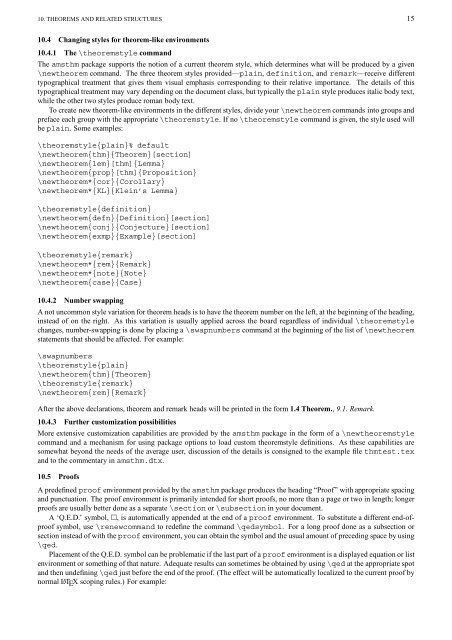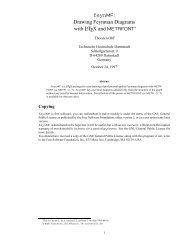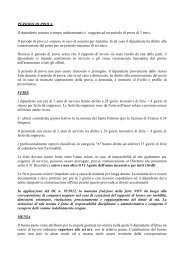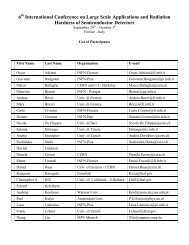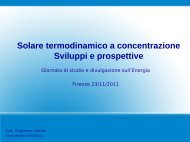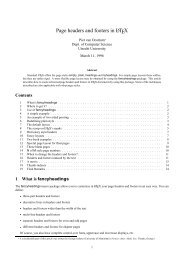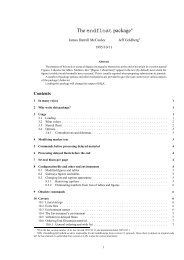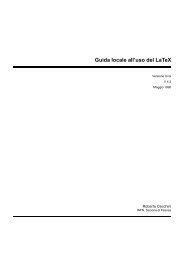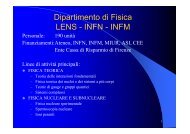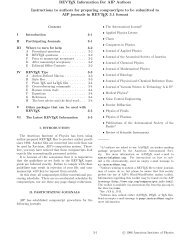14 10. THEOREMS AND RELATED STRUCTURES—10—Theorems and related structures (amsthm package)10.1 IntroductionThe amsthm package provides an enhanced version of the <strong>LATEX</strong> command \newtheorem for defining theorem-like environments.The amsthm version of the \newtheorem command recognizes a \theoremstyle specification (as inMittelbach’s theorem package) and has a * form for defining unnumbered environments. The amsthm package also definesa proof environment that automatically adds a Q.E.D. symbol at the end. <strong>AMS</strong> document classes automatically loadthe amsthm package, so everything described here applies to them as well. An example file thmtest.tex is provided inthe <strong>AMS</strong>-<strong>LATEX</strong> distribution.10.2 The \newtheorem commandIn mathematical research articles and books, theorems and proofs are among the most common elements, but authors alsouse many others that fall in the same general class: lemmas, propositions, axioms, corollaries, conjectures, definitions,remarks,, cases, steps, and so forth. As these elements form a slice of the text stream with well-defined boundaries, they arenaturally handled in <strong>LATEX</strong> as environments. But <strong>LATEX</strong> document classes normally do not provide predefined environments fortheorem-like elements because (a) that would make it difficult for authors to exercise the necessary control over the automaticnumbering, and (b) the variety of such elements is so wide that it’s just not possible for a document class to provide every onethat will ever be needed. Instead there is a command \newtheorem, similar to \newenvironment in effect, that makesit easy for authors to set up the elements required for a particular document.The \newtheorem command has two mandatory arguments; the first one is the environment name that the author wouldlike to use for this element; the second one is the heading text. For example,\newtheorem{lem}{Lemma}means that instances in the document of\begin{lem} Text text ... \end{lem}will produceLemma 1. Text text :::where the heading consists of the specified text ‘Lemma’ and an automatically generated number and punctuation.If \newtheorem* is used instead of \newtheorem in the above example, there will not be any automatic numbersgenerated for any of the lemmas in the document. This form of the command can be useful if you have only one lemma anddon’t want it to be numbered; more often, though, it is used to produce a special named variant of one of the common theoremtypes. For example, if you have a lemma whose name should be ‘Klein’s Lemma’ instead of ‘Lemma’ + number, then thestatement\newtheorem*{KL}{Klein’s Lemma}would allow you to write\begin{KL} Text text ... \end{KL}and get the desired output.10.3 Numbering modificationsIn addition to the two mandatory arguments, \newtheorem has two mutually exclusive optional arguments. These affectthe sequencing and hierarchy of the numbering.By default each kind of theorem-like environment is numbered independently. Thus if you have three lemmas and twotheorems interspersed, they will be numbered something like this: Lemma 1, Lemma 2, Theorem 1, Lemma 3, Theorem2. If you want lemmas and theorems to share the same numbering sequence—Lemma 1, Lemma 2, Theorem 3, Lemma 4,Theorem 5—then you should indicate the desired relationship as follows:\newtheorem{thm}{Theorem}\newtheorem{lem}[thm]{Lemma}The optional argument [thm] in the second statement means that the lem environment should share the thm numberingsequence instead of having its own independent sequence.To have a theorem-like environment numbered subordinately within a sectional unit—e.g., to get propositions numberedProposition 2.1, Proposition 2.2, and so on in Section 2—put the name of the parent unit in square brackets in final position:\newtheorem{prop}{Proposition}[section]With the optional argument [section], theprop counter will be reset to 0 whenever the parent counter section isincremented.
10. THEOREMS AND RELATED STRUCTURES 1510.4 Changing styles for theorem-like environments10.4.1 The \theoremstyle commandThe amsthm package supports the notion of a current theorem style, which determines what will be produced by a given\newtheorem command. The three theorem styles provided—plain, definition, andremark—receive differenttypographical treatment that gives them visual emphasis corresponding to their relative importance. The details of thistypographical treatment may vary depending on the document class, but typically the plain style produces italic body text,while the other two styles produce roman body text.To create new theorem-like environments in the different styles, divide your \newtheorem commands into groups andpreface each group with the appropriate \theoremstyle. Ifno\theoremstyle command is given, the style used willbe plain. Some examples:\theoremstyle{plain}% default\newtheorem{thm}{Theorem}[section]\newtheorem{lem}[thm]{Lemma}\newtheorem{prop}[thm]{Proposition}\newtheorem*{cor}{Corollary}\newtheorem*{KL}{Klein’s Lemma}\theoremstyle{definition}\newtheorem{defn}{Definition}[section]\newtheorem{conj}{Conjecture}[section]\newtheorem{exmp}{Example}[section]\theoremstyle{remark}\newtheorem*{rem}{Remark}\newtheorem*{note}{Note}\newtheorem{case}{Case}10.4.2 Number swappingA not uncommon style variation for theorem heads is to have the theorem number on the left, at the beginning of the heading,instead of on the right. As this variation is usually applied across the board regardless of individual \theoremstylechanges, number-swapping is done by placing a \swapnumbers command at the beginning of the list of \newtheoremstatements that should be affected. For example:\swapnumbers\theoremstyle{plain}\newtheorem{thm}{Theorem}\theoremstyle{remark}\newtheorem{rem}{Remark}After the above declarations, theorem and remark heads will be printed in the form 1.4 Theorem., 9.1. Remark.10.4.3 Further customization possibilitiesMore extensive customization capabilities are provided by the amsthm package in the form of a \newtheoremstylecommand and a mechanism for using package options to load custom theoremstyle definitions. As these capabilities aresomewhat beyond the needs of the average user, discussion of the details is consigned to the example file thmtest.texand to the commentary in amsthm.dtx.10.5 ProofsApredefinedproof environment provided by the amsthm package produces the heading “Proof” with appropriate spacingand punctuation. The proof environment is primarily intended for short proofs, no more than a page or two in length; longerproofs are usually better done as a separate \section or \subsection in your document.A ‘Q.E.D.’ symbol, , is automatically appended at the end of a proof environment. To substitute a different end-ofproofsymbol, use \renewcommand to redefine the command \qedsymbol. For a long proof done as a subsection orsection instead of with the proof environment, you can obtain the symbol and the usual amount of preceding space by using\qed.Placement of the Q.E.D. symbol can be problematic if the last part of a proof environment is a displayed equation or listenvironment or something of that nature. Adequate results can sometimes be obtained by using \qed at the appropriate spotand then undefining \qed just before the end of the proof. (The effect will be automatically localized to the current proof bynormal <strong>LATEX</strong> scoping rules.) For example:


